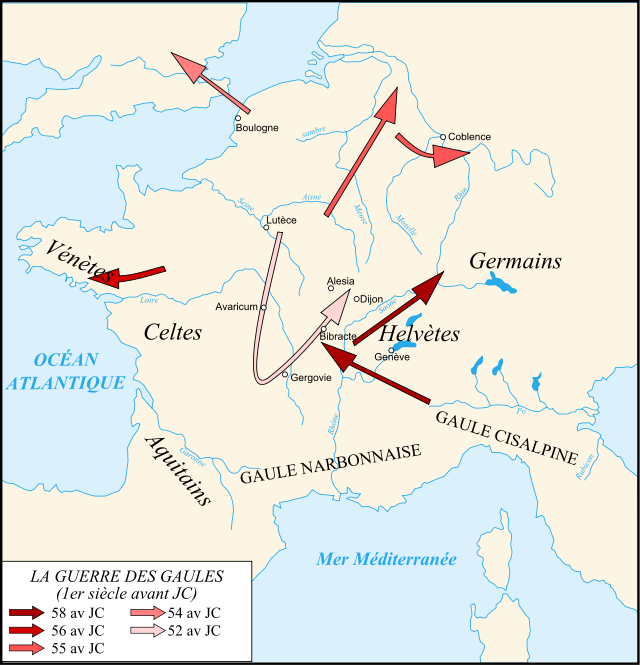A chronology
|
58 av JC
57 av JC 56 av JC 55 av JC 54 av JC 53 av JC 52 av JC 51 av JC |
At this time the Gauls in the region of the Alps were already under Roman control.
The Helvetii began to migrate towards the lands of the Santons (Saintes). Caesar would not let them cross Provincia, so they moved towards the lands of the Eduens whose capital was Bibracte (Mont Beuvray). Caesar defeated the Helvetii in battle at Bibracte. Caesar attacks the Ariovist German leader who has established himself in the Sequanes (Jura) and defeats him in Vesontio (Besancon). Roman Expedition against the Belgae in Gaul to the north of the river Seine. Caesar wins many victories. Land and sea war against the Venetes (Morbihan) who are defeated at sea. Expedition of the legate Publius Crassus in Aquitaine. A final expedition against the Morins and the Menapiens was carried out quickly. A punitive expedition against the Germani. In summer, Caesar crossed the channel with a small force landed to make an incursion in Brittany (present-day England). Caesar returned to Brittany (present day England) with five legions and defeated the Cassivellaunus army at Devils Dyke (near present-day St Albans). He takes with him his Gallic allies and vassals. Among them, a very young cavalry officer named Vercingetorix. Aged 20, Vercingetorix, now chief of the Arverni, a people never occupied by the Roman legions, fomented a secret coalition between the Gallic tribes against the menace that Caesar represented for their independence. Caesar returned from Italy to chase the Gauls northwards. Vercingetorix destroyed everything in his wake, but spared Avaricum (Bourges), capital of the Bituriges and Caesar was able to take Avaricum, secure provisions and reconstitute his forces. The Carnutes massacred the Roman merchants established at Cenabum (Orleans). Caesar took Cenabum and spared Avaricum. The Eduens, despite normally being allies of the Romans, sent cavalry to join Vercingetorix who establshed his forces at at Gergovie, near present day Clermont-Ferrand, where Caesar could not dislodge them. The Gauls lead by Vercingetorix later attacked the Romans in Provincia (around Narbonne). The conflict took a decisive turn when the cavaliers of the Gauls were pushed into retreat by Caesar's Germani allies. Vercingetorix had to flee and take refuge with 80,000 men at Alesia, a hill fort in the east of Gaul. Vercingetorix surrendered after the siege of Alesia. Massacre of Roman merchants established in Cenabumdes (Orleans) by the Carnutes. Caesar took Cenabum then Avaricum (Bourges). Caesar consolidates his victory by punitive expeditions against the last island of resistance: Uxellodunum. |
From the 19th century to the present day
|
91865
1866 - 1874 1913 - 1920 1920 - 1941 1997 2001 2008 2010 - 2011 2012 - 2019 |
Discovery by Jean-Baptiste Cessac of many artefacts and the first tunnel at the Loulié spring.
Excavations carried out at the instigation of Napoleon III. Etienne Castagné published many reports, following which Napoleon III, in his work on the Gallic wars, declared Puy d’Issolud to be the site of Uxellodunum. Excavations carried out by Antoine Cazes at the Loulié spring. Excavations carried out by Antoine Laurent-Bruzy, a local enthusiast. New archeological excavations begin under the direction of Jean-Pierre Girault. On 26th April 2001, official recognition of Puy d'Issolud as the site of Uxellodunum. The conclusion of the recent archeological excavations carried out by Jean-Pierre Girault at the Loulié spring. Work carried out on the restoration of the site at the Loulié spring and protection of the tunnels, including processing of the spoil and recording finds. The site is currently closed to the public. |



